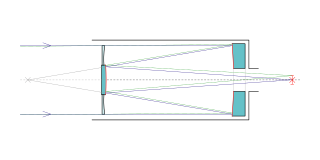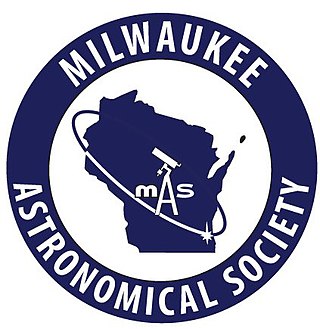Boyden Observatory is an astronomical research observatory and science education centre located in Maselspoort, 20 kilometres (12 mi) north-east of the city of Bloemfontein in Free State, South Africa. The observatory is managed by the Physics Department of the University of the Free State (UFS). The Friends of Boyden assist the observatory as a public support group, organising open evenings and protecting its public interest. Boyden also makes use of members of ASSA Bloemfontein Centre, the amateur astronomy club of the city, for presenters and telescope assistants.

The Schmidt–Cassegrain is a catadioptric telescope that combines a Cassegrain reflector's optical path with a Schmidt corrector plate to make a compact astronomical instrument that uses simple spherical surfaces.
Stull Observatory is an astronomical observatory owned and operated by Alfred University located in Alfred, New York (USA) and named after John Stull, who helped establish the observatory in 1966. It is notable for housing seven independently housed telescopes ranging in size from 8 to 32 inches. The largest, the Austin-Fellows 32 inch Newtonian Reflector is tied with the Vassar College Class of 1951 Observatory for the rank of second largest optical telescope in New York state after the 40 inch telescope at SUNY Oneonta College Observatory. Telescopes at the observatory are regularly opened to the public. The observatory is also used for those pursuing a minor in astronomy or a concentration in astrophysics.
Naylor Observatory is an astronomical observatory owned and operated by Astronomical Society of Harrisburg. It is located near Lewisberry, Pennsylvania, United States.
Brooks Astronomical Observatory is an astronomical observatory owned and operated by Central Michigan University. It is located in Mount Pleasant, Michigan (USA). The observatory was established in 1964 and is located on the roof of the Brooks Hall science building. Both the building and observatory are named for Kendall P. Brooks, instructor of astronomy and other subjects in the period of 1910-1947.

Mills Observatory is the first purpose-built public astronomical observatory in the UK, located in Dundee, Scotland. Built in 1935, the observatory is classically styled in sandstone and has a distinctive 7 m dome, which houses a Victorian refracting telescope, a small planetarium, and display areas. The dome is one of two made from papier-mâché to survive in the UK, the other being at the Godlee Observatory.

The Monterey Institute for Research in Astronomy (MIRA) is an independent, non-profit, professional astronomical observatory dedicated to astronomical education and research, near Monterey, California. It was the first private professional observatory in the United States to open in the 20th century.

The Givatayim Observatory is a public observatory that was founded in 1968 by the Israeli Astronomical Association and the Givatayim municipality.

The Heights Observatory is an Astronomical Observatory at The Heights School in Modbury Heights, Adelaide, South Australia.

J A Jones Hoober Observatory is a privately owned observatory located in South Yorkshire, England near to the villages of Hoober and Wentworth, 4 miles (6.4 km) North-northwest of Rotherham. It can be found about 300 metres (0.19 mi) east of Hoober Stand. The observatory is owned and operated by Mexborough & Swinton Astronomical Society (NPO).
The SUNY Oneonta Observatory is an astronomical observatory in Oneonta, New York, home to the state's largest optical telescope and one of the largest publicly open east of the Mississippi, a one-meter Newtonian reflector constructed by JMI Telescopes of Lakewood, Colorado.

Sutherland Astronomical Society Incorporated (SASI) is an amateur astronomical society based in the Sutherland Shire, in the southern suburbs of Sydney, Australia. It operates the Green Point Observatory, it is one of the two founding organizations of the National Australian Convention of Amateur Astronomers, and its members have discovered two comets and two novae.
The Von Braun Astronomical Society is a society of amateur and professional astronomers dedicated to education and public outreach on behalf of astronomy based in Huntsville, Alabama, United States.

The Mount Stony Brook Observatory is an astronomical observatory operated by Stony Brook University in Stony Brook, New York. It is located on the roof of the Earth and Space Sciences Building. The dome contains a Meade 14" Maksutov–Cassegrain telescope and SBIG (SBIG-STL1001e) imaging equipment. The telescope is used for teaching undergraduate and graduate astronomy labs by the department, as well as by the Astronomy club. The observatory's imaging capabilities have been used to monitor variable stars. On the first Friday of every month during the school year the department hosts "Astronomy Open Nights" during which a lecture is given, followed by observing if the weather permits. The observatory was built in 1968 and Astronomy Open Nights have been held there since 1976. The current telescope was installed in 1981.
Mount Burnett Observatory is an astronomical observatory in Mount Burnett, Victoria, Australia.
The Helmut Ullrich Astronomical Observatory is an observatory situated on Col Drusciè, a mountain peak in the Dolomites located within Cortina d'Ampezzo, Italy. The observatory sits at an elevation of 1,780 metres (5,840 ft) above sea level and includes two domes, with a 20" Newtonian telescope and an 11" Schmidt–Cassegrain telescope inside.
The Dark Sky Observatory (DSO) is an astronomical observatory owned and operated by Appalachian State University (ASU). It is located 9 kilometers (5.6 mi) east of Deep Gap, North Carolina (USA), off of the Blue Ridge Parkway, and 32 kilometers (20 mi) east of the ASU campus in Boone, North Carolina It was established in 1981, and is used for research, instruction, and public viewing events. The Cline Visitors' Center was completed in 2011.
Tortugas Mountain Observatory (TMO) is an astronomical observatory owned and operated by New Mexico State University (NMSU). It is located on Tortugas Mountain, also known locally as 'A' Mountain, in southern New Mexico (USA), approximately 8 kilometers (5.0 mi) southeast of Las Cruces and 4 kilometers (2.5 mi) east of the NMSU campus. Founded in 1963 under the supervision of Clyde Tombaugh, the observatory focused on observing the planets. Much of the information captured at TMO is now available through the Planetary Data System's Atmospheres Node, which is managed by NMSU. The two-dome observatory building was completed in 1964, though observing began with one of the telescopes in 1963. A second building, with a larger single dome, was completed at the opposite end of the ridgeline of Tortugas Mountain in 1967. Regular use of TMO ceased in 1999 or 2000, but the observatory equipment was not dismantled. In 2008 it was used for the Lunar Crater Observing and Sensing Satellite project. In 2010, efforts to revive the observatory for use by the American Association of Variable Star Observers began. As of 10 June 2011, work on project was reported to be 60-75% done.

Bayfordbury Observatory is the University of Hertfordshire's astronomical and atmospheric physics remote sensing observatory, and one of the largest teaching observatories in the UK. It is located in the relatively dark countryside of Bayfordbury, Hertfordshire, 6 miles from the main university campus in Hatfield. The first telescope was built in 1969, and since then has been used as a teaching observatory for undergraduate students, staff and student research as well as for public outreach activities.

The Milwaukee Astronomical Society (MAS) is a 501(c)(3) tax-exempt organization serving amateur astronomers in the greater Milwaukee area since 1932, making it one of the oldest continuously running astronomy clubs in the nation. The MAS operates an observatory, one of the largest amateur club observatories in the world. The current membership is 270.











